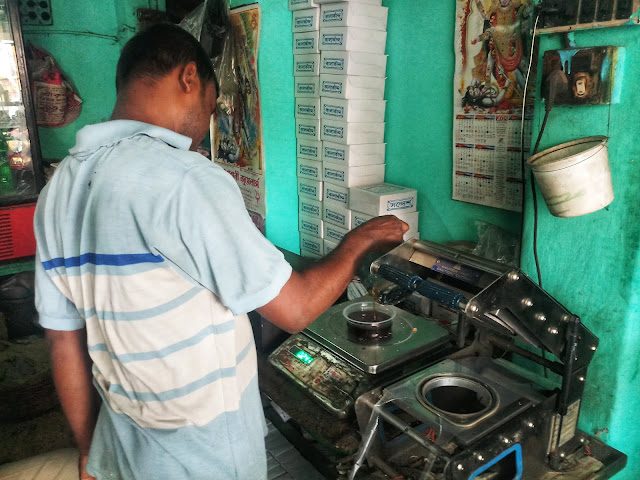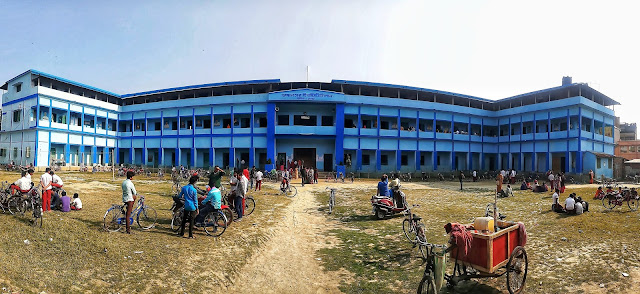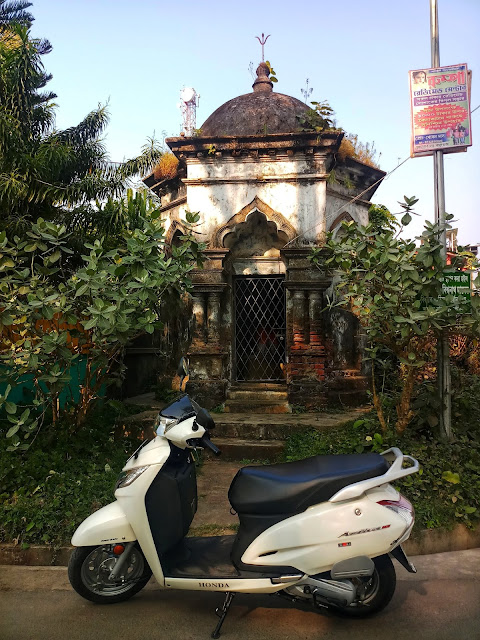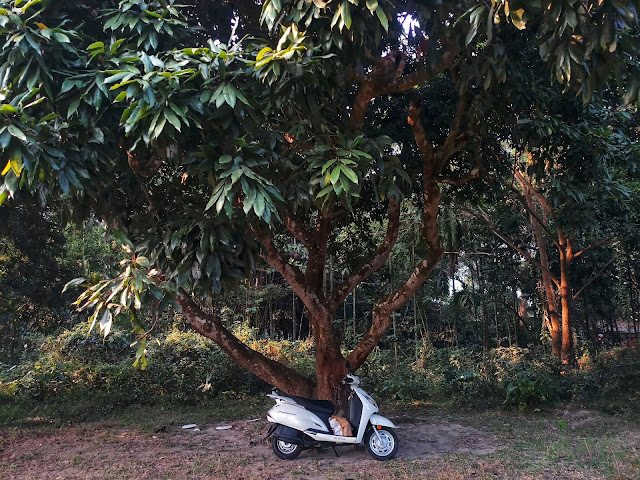ব্যানার্জী বড় বাড়ির পুজো, পুর্বনওপাড়া, মাকড়দহ, হাওড়া।
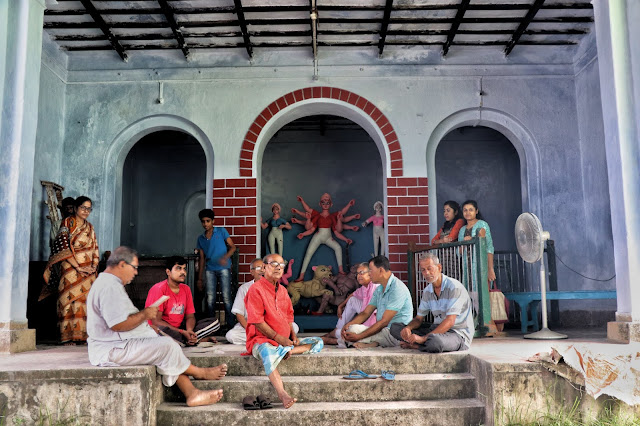 |
| The Banerjee family gathers at the sprawling Durga Dalan of Barobar |
হাওড়ার ডোমজুড় ব্লকের মাকড়দহ বহু পুরোনো জনপদ। এখানে রয়েছে বহু প্রাচীন এবং বিখ্যাত মাকড়চন্ডী মন্দির, যার নাম অনুসারে এই জায়গার নাম। জমিদার রামকান্ত কুন্ডুচৌধুরী বর্তমান মন্দিরটি তৈরী করান ১৭৪৩ সালে। যদিও এর বহু আগে থেকেই এই চন্ডী মন্দিরের অস্তিত্ব ছিল। এই চন্ডী সম্ভবত লোকায়ত দেবী ছিলেন। এই মন্দিরের ইতিহাসের সঙ্গে মঙ্গলকাব্যের যোগ পাওয়া যায়। এককালে এই অঞ্চল দিয়ে সরস্বতী নদী প্রবাহিত হত। আজকের দিনেও এই অঞ্চলের কিছু পুকুর, খাল ইত্যাদির মধ্যে মজে যাওয়া সেই নদীর চিহ্ন খুঁজে পাওয়া যায়। লোককথা অনুসারে এই সরস্বতী নদী বেয়ে নৌকা নিয়ে বাণিজ্যে যাওয়ার পথে স্বপ্নাদেশ পেয়ে ধনপতি সদাগরের পুত্র শ্রীমন্ত সদাগর চন্ডীমাতার এই মন্দির তৈরী করান। বর্তমান মন্দিরে রাখা তিনটি পাথর আজও সেই পুরোনো মন্দিরের অস্তিত্বের চিহ্ন বহন করছে।
মহালয়ার দিন সকালে আমি আর বন্ধু অমিতাভ গুপ্ত এসেছিলাম মাকড়দহের ব্যানার্জী বাড়িতে। এবছর আমাদের এখানে আসা এই বাড়ির মেয়ে পুজা ব্যানার্জীর নিমন্ত্রণে। ওদের বাড়ীর বহু পুরোনো দুর্গাপূজার ইতিহাস জেনে নেওয়ার সুযোগ হয়েছিল।
ব্যানার্জী বড় বাড়ির পুজো এই অঞ্চলে যথেষ্ট পরিচিত সেটা আসার সময়ই বুঝতে পেরেছিলাম। পথনির্দেশ অনুসারে খুঁজে পেতে কোন অসুবিধে হয়নি। ব্যানার্জী বাড়ি যাবো শুনতেই স্থানীয় মানুষরা সাগ্রহে রাস্তা দেখিয়ে দিয়েছেন।
পুর্বনওপাড়ায় একটি পুকুরের পাশ দিয়ে রাস্তা চলে গেছে ব্যানার্জী বাড়িতে। দূর থেকেই চোখে পড়ে সবুজ রঙ করা বড় বাড়ি, সামনে আটচালা শিবমন্দির। কালো কাঠের বিরাট দরজা দেওয়া মূল ফটক পেরিয়েই প্রশস্ত আঙ্গিনা, যদিও বাঁধানো নয়। সেকালের বাড়ির নির্মাণশৈলী মেনে সামনে দুর্গাদালান আর তিনদিক ঘিরে দোতলা বসত বাড়ি। পুরো মাঠ জুড়ে ম্যারাপ বাঁধা। দেবীপক্ষের শুরুতে আসন্ন পুজোর আয়োজনের ব্যাস্ততা শুরু হয়ে গেছে। তিন খিলানের ঠাকুর দালানে প্রতিমা তৈরীর কাজ চলছে। মৃণ্ময়ী থেকে চিণ্ময়ী হয়ে ওঠার চিরন্তন প্রক্রিয়া। বাড়ির পুজোর রীতি মেনে একচালার ঠাকুর। প্রতিমার অঙ্গরাগে গোলাপী রঙের ছোঁয়া। এমনটিই চলে আসছে বহু বছর ধরে। ছুটির দিনে পরিবারের অনেকেই জড়ো হয়েছেন ঠাকুর দালানে। তাঁদের সঙ্গে আলাপচারিতায় উঠে এল এই পরিবার এবং দুর্গাপুজোর অনেক ইতিহাস।
 |
| Main entrance of Boro bari of Banerjee Family |
 |
| The Shiva Temple opposite the main entrance of Borobari |
 |
| The idol at Barobari |
 |
| A little member of the Banerjee family before the idol |
ব্যানার্জী বাড়ির দুর্গাপুজা হয়ে আসছে আনুমানিক ২৫০ বছরেরও বেশি সময় ধরে। আনুমানিক শব্দটি ব্যবহার করা হল কারণ দুর্গাপুজার শুরুর সঠিক বছরটি সম্মন্ধে কোন প্রামাণ্য তথ্য পাওয়া যায় নি। তবে এই বাড়ির ইতিহাস জানতে গেলে সময়ের চাকা ঘুরিয়ে আমাদের ফিরে যেতে হবে ২৮০ বছর আগে যখন সুবে বাংলায় নবাবী শাসন চলছে। সেই সময় মসনদে নবাব আলীবর্দী খান। ১৭৪০ সন নাগাদ উড়িষ্যার দখল নিয়ে তৎকালীন শাসক রুস্তম জঙ এর সঙ্গে তাঁর মনোমালিন্য শুরু হয়। ফলতঃ যুদ্ধ এবং রুস্তম জঙের পতন। এইসময় প্রতিশোধ নেওয়ার জন্য রুস্তম জঙ শরণ নেন নাগপুরের মারাঠা শাসক রাঘোজী ভোঁসলের। মারাঠাদের সাহায্যে আবার উড়িষ্যা দখল এবং ফের আলিবর্দীর বাহিনীর হাতে পরাজয়ের মধ্যেই এক অন্য সর্বনাশের বীজ বপন হয়। ১৭৪১ সাল থেকে মারাঠা সেনাপতি ভাস্কর পন্ডিতের নেতৃত্বে বাংলার বুকে শুরু হয় বর্গী হানা। পরবর্তী ১০ বছরে বর্গী আক্রমণ বাংলার বুকে অভূতপুর্ব ত্রাস তৈরী করেছিল। অবাধ, লুন্ঠন, হত্যা, ধর্ষণের তান্ডবে গ্রামকে গ্রাম ছারখার হয়ে গিয়েছিল। লোকে প্রাণভয়ে দিগবিদিক জ্ঞানশূণ্য হতে ভিটেমাটি ছেড়ে পালাতে শুরু করেছিল। শোনা যায় এই দশ বছরে বর্গী হানায় বাংলায় প্রায় চার লাখ লোকের প্রাণহানি ঘটে। নবাবের সেনাবাহিনী বহু চেষ্টা করেও বর্গী আক্রমণ ঠেকাতে পারেনি। বাংলার ইতিহাসে এই দশ বছর এক মারাত্মক গণহত্যার কালো অধ্যায় হিসেবেই রয়ে গেছে।
এই প্রসঙ্গ টানার উদ্দেশ্য একটাই। মাকড়দহতে ব্যানার্জী পরিবারের বসবাসের ইতিহাসের সঙ্গে অনুঘটক হিসেবে জড়িয়ে আছে বর্গী আক্রমণের পর্ব। ঠাকুরদালানে বসে সেই কাহিনীই শুনছিলাম পরিবারের এক প্রবীণ সদস্য সৌমেন ব্যানার্জীর মুখে।
মাকড়দহে ব্যানার্জী পরিবারের বসবাসের শুরু হয় আদিপুরুষ জগদীশ বাচস্পতির আগমনের সঙ্গে। আদতে তাঁর নিবাস ছিল হুগলী জেলার শিয়াখালার কাছে বাগান্দা গ্রামে। পদবী বন্দোপাধ্যায় হলেও জগদীশ মহাশয়ের উপাধি ছিল বাচস্পতি। উনি ছিলেন কুলীন ব্রাহ্মণ এবং ইতিহাসের কান্যকুব্জ বা কনৌজ থেকে একসময় বাংলায় আগত ব্রাহ্মণ বংশের উত্তরপুরুষ। শাস্ত্রজ্ঞ পন্ডিত হিসেবে গ্রামে পুজা অর্চনা আর যজমানী করেই জীবিকা নির্বাহ করতেন। খুব সম্ভবতঃ ১৭৪২ সন বা তার কিছু পরে বর্গী আক্রমণের দরুণ তিনি পরিবারসহ ভিটে ছাড়তে বাধ্য হন এবং নিরাপদ আশ্রয়ের সন্ধানে বেরিয়ে পড়েন। সেই সময় তিনি শুধু তাঁর আরাধ্য শালগ্রাম শিলা, যেটি নারায়ণের প্রতিভূ এবং বংশপরম্পরায় পুজিত হয়েছে সেটি আর মা মনসার প্রতীক একটি মনসা গাছের ডাল শুধু সঙ্গে নিতে পেরেছিলেন। বাচস্পতি মহাশয়ের শালগ্রাম শিলাটি হিন্দুশাস্ত্র মতে অতি পবিত্র এবং দুর্লভ অনন্তদেব শিলা। চরম দুঃসময়ে দাঁড়িয়েও তিনি আরাধ্য ইষ্টদেবতাকে হাতছাড়া করেননি। যাত্রার সময় সর্বক্ষণ তিনি শিলাটিকে পরম যত্নে কাপড় দিয়ে বেঁধে নিজের গলায় ঝুলিয়ে রেখেছিলেন।
নিরাপদ আশ্র্য়ের সন্ধানে ঘুরতে ঘুরতে অবশেষে তিনি এসে পড়েন সরস্বতী নদীর তীরে এই মাকড়দহ গ্রামে। এখানেই তাঁর যাত্রা শেষ হয়ে আবার শুরু হয় তাঁর জীবনের নতুন অধ্যায়। মাকড়দহতে তাঁর বসবাস শুরুর পিছনেও কয়েকটি কারণ ছিল বলে আমার মনে হয়েছে। সেই সময় বাংলার পল্লীজীবনে ওতপ্রোত ভাবে জড়িয়ে থাকত ধর্ম। সাধারণ মানুষের জীবনযাত্রার অধিকাংশই নিয়ন্ত্রিত ছিল বিভিন্ন ধর্মীয় অনুশাসনের মাধ্যমে। শুধু পুজোআচ্চাই নয়, সামাজিক জীবনের প্রতিটি ক্ষেত্রে যেহেতু ধর্মের সংস্রব ছিল আর ধর্মীয় তথা শাস্ত্রীয় ব্যাখ্যা তথা নিয়ন্তার অধিকারী ছিলেন একমাত্র ব্রাহ্মণকুল, সেই কারণেই সমাজে তাঁদের বিশেষ মর্যাদা দিয়ে রাখা হত। সেইসময়ে এক অঞ্চল থেকে অন্য অঞ্চলে যাতায়াতের সুযোগ সুবিধা নিতান্তই অল্প ছিল এবং মানুষের জীবন সাধারণতঃ নিজের গ্রামকে ঘিরেই আবর্তিত হত। সেকারণে যে কোন গ্রামে অন্তত একঘর ব্রাহ্মণের বসবাস কাম্য ছিল। এরকম উদাহরণও আছে যে যদি কোন গ্রামে ব্রাহ্মণের অভাব থাকত, গ্রামের স্বচ্ছল ব্যাক্তি, ব্যবসায়ী বা জমিদাররা নিজেরা বা সকলে মিলে উদ্যোগী হয়ে জমিদান করে ব্রাহ্মণের বসত করিয়েছেন। জগদীশ বাচস্পতি মহাশয় যে সময় মাকড়দহতে আসেন সেই সময় সরস্বতী নদীর নৈকট্যের কারণে ব্যাবসাবাণিজ্য এবং মন্দিরের কল্যাণে এই অঞ্চলে যথেষ্ট মানুষের বসবাস ছিল এবং বাইরের লোকের আনাগোনাও লেগে থাকত। বাচস্পতি মহাশয় যখন এই অঞ্চলে এসে উপস্থিত হন সেসময়ে এই অঞ্চলের জমিদারী ছিল হাওড়ার মাহীয়ারির কুন্ডুচৌধুরী বংশের হাতে। সে সময় বাচস্পতি মহাশয়ের মত শাস্ত্রজ্ঞ ব্রাহ্মণের আগমন তাঁদের এবং স্থানীয় মানুষদের কাছে আনন্দের খবর ছিল। সেসময় স্থানটি ব্রাহ্মণবর্জিত থাকায় নিত্যপুজা ও অনান্য ধর্মাচরণের সুবিধার জন্য কুন্ডুচৌধুরীরাই মাকড়দহের পুর্বপ্রান্তে জমি নির্দিষ্ট করে দেন বাচস্পতি মহাশয়ের বসবাসের জন্য। এতে স্থানীয় মানুষদেরও সানন্দ সমর্থন ছিল। সেই শুরু। এই জমিতেই অনন্তদেব শিলা প্রতিষ্ঠিত হয় এবং নিত্যপুজা শুরু হয়। আজও পুরুষানুক্রমে তাঁর বংশধররা এই ভিটেতেই বসবাস করছেন। জায়গাটি তৎকালীন গ্রামের পুর্বপ্রান্তে এবং নতুন বসতি হওয়ার ক্রমে লোকমুখে পুর্ব্বনওপাড়া নামে পরিচিত হয়। এখানে আসার সময় জগদীশ বাচস্পতি যে মনসা ডালটি সঙ্গে এনেছিলেন সেটি ভিটের অদুরে পুঁতে দেন। কালক্রমে সেটি বড় গাছে রুপান্তরিত হয়ে মনসাতলা নামে পরিচিতি পায়। এপ্রসঙ্গে পরে আরো বিস্তারিত বলছি।
দুর্গাপুজোর শুরু জগদীশ বাচস্পতির হাত ধরেই, তবে শুরুর সঠিক সাল আজ আর জানা যায় না, যেমন ঠিক জানা যায় না ঠিক কবে থেকে এই ভিটেতে তিনি বসবাস শুরু করেন। তবে অনুমান করা যায়, এখানে বসবাস শুরু করার কিছুকাল পরে খানিকটা স্থিতু হয়ে উনি দুর্গাপুজা শুরু করেন। সেই হিসেব দেখতে গেলেও এই পুজোর বয়স ২৫০ বছরের বেশি তো বটেই।
আজকের এই বসতবাটি বা দুর্গাদালান সে সময় ছিল না। মাটির ঘরের আঙ্গিনাতেই হয়ত শুরু হয়েছিল দেবী দুর্গার আবাহন।
এপ্রসঙ্গে সৌমেনবাবুর কাছে পরিবারের পরবর্তী প্রজন্মের ইতিহাস সম্পর্কে আরো কিছু জানা গেল। জগদীশ বাচস্পতির চার পুত্রসন্তান, রামকৃষ্ণ বিদ্যানিধি, গঙ্গারাম, বলরাম ও অযোধ্যারাম। মৃত্যুর আগে তিনি জ্যেষ্ঠপুত্র রামকৃষ্ণর হাতে পারিবারিক বিগ্রহের নিত্যপুজার ভার দিয়ে যান। আজকের ব্যানার্জী পরিবার এই রামকৃষ্ণের বংশেরই উত্তরসুরী। এঁরই বংশধররা এই আদি ভিটে মনসাতলা এবং আশপাশের এলাকায় ছড়িয়ে পড়েন।
রামকৃষ্ণের জেষ্ঠ্যপুত্র ছিলেন রামকানাই। বস্তুত তাঁর আমল থেকেই ব্যানার্জী পরিবারের অর্থনৈতিক অবস্থার উন্নতি শুরু হয়। রামকানাই এবং তাঁর পুত্ররা ব্যবসায়ে প্রভূত অর্থ উপার্জন করেন। রামকানাই তাঁদের আদিভিটে, মনসাতলা ছেড়ে সরে এসে কাছেই অন্য জমিতে বাড়ি বানিয়ে বসবাস শুরু করেন। অনন্তদেবের নিত্যসেবার দায়িত্ব তাঁর উপরেই ন্যস্ত ছিল এবং এই বাড়িতেই তিনি নারায়ণ শিলা প্রতিষ্ঠা করেন। রামকানাই যেহেতু বাচস্পতি মহাশয়ের জেষ্ঠপুত্রের সন্তান ছিলেন এবং নিজেও ছিলেন তাঁর বড় ছেলে, তাঁর তৈরি করা সেই বাড়ি লোকমুখে হয়ে যায় 'বড়বাড়ি'। আজ যে বাড়ির ঠাকুর দালানে বসে এই কাহিনী শুনছি সেটাই হল এই বড়বাড়ি। এই বাড়ির চেহারা অবশ্য প্রথম থেকেই এমন ছিল না। শুরুতে হয়ত মাটিরই ছিল, তারপর বংশানুক্রমে তৈরী হতে হতে আড়েবহরে বেড়ে আজকের চেহারা পেয়েছে। এই দুর্গাদালান সংলগ্ন মন্দিরেই শালগ্রাম শিলা শ্রীশ্রী অনন্তদেব নিত্য পুজিত হন।
 |
| The sacred stone representing Narayan or lord Vishnu Salgram Shila, Anantadeb |
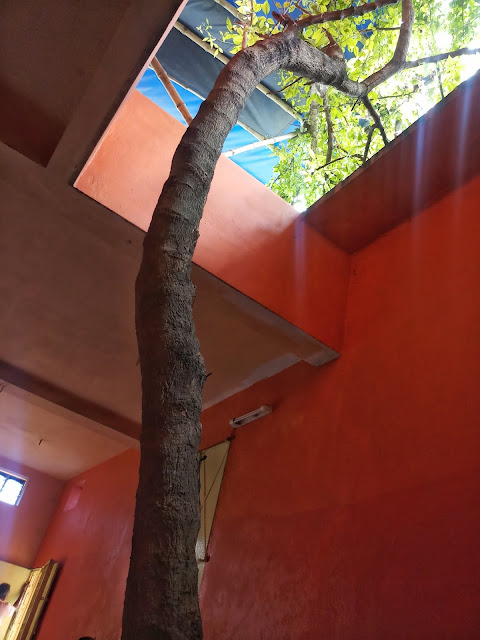 |
| The remnants of the original Manasa Tree at Manasatala Banerjee family. |
পরিবার বড় হওয়ার সঙ্গে সঙ্গে ব্যানার্জী গোষ্ঠী এই এলাকায় আরো ছড়িয়ে পড়তে থাকেন। রামকৃষ্ণের অনান্য উত্তরসুরীরা, যেমন রামকৃষ্ণের তৃতীয় পুত্র রামলক্ষণ এবং তাঁর কনিষ্ঠ সহোদররা বড়বাড়ি ছেড়ে এর উত্তর-পূর্ব দিকে আলাদা বাড়ি বানিয়ে থাকতে শুরু করেন। পরে এই এলাকার নাম হয় 'নতুন বাড়ি'।
 |
| The Natunbari of Banerjee Family |
বর্তমানে ব্যানার্জী পরিবার "বড়বাড়ি", "মনসাতলা" এবং "নতুনবাড়ি" এই তিনটি এলাকা নিয়ে ছড়িয়ে ছিটিয়ে থাকেন। আর পুরো এলাকাটা ব্যানার্জী পাড়া হিসেবেই পরিচিত। তবে এই বড়বাড়িই হল ব্যানার্জী পরিবারের ভরকেন্দ্র। বিত্ত বৈভবে বড় ছেলে রামকানাইয়ের পরিবারের এই শাখাটিই উল্লেখযোগ্য। ব্যানার্জী পরিবার ছাড়াও এই অঞ্চলে তাঁদের কারুর কারুর মাতুল / দৌহিত্র বংশও এই গ্রামে বসতি করেন। এর মূল কারণ ছিল যে পরিবারের কারুর মৃত্যুর পর অশৌচ লাগলে শাস্ত্রমতে অনন্তদেবের নিত্যপুজার ব্যাঘাত ঘটবে। এমতবস্থায় দৌহিত্র বংশের কেউ নিত্যপুজার ভার নিতে পারেন। সেই কারণেই এঁদের এখানে আসা। ব্যানার্জী গোষ্ঠী ছাড়াও গ্রামে মুখোপাধ্যায়, চট্টোপাধ্যায়, গঙ্গোপাধ্যায় ইত্যাদি পদবীধারীদেরও বসবাস আছে। এখানে আরো উল্লেখ করা যেতে পারে যে এনাদের আদিনিবাস বাগান্দা গ্রামে ব্যানার্জী বংশের একটি শাখা আজও রয়ে গেছে। যদিও আজকের দিনে দাঁড়িয়ে বাগান্দার ব্যানার্জী বংশের সঙ্গে মাকড়দহের ব্যানার্জী বংশের যোগাযোগ খুঁজে বের করা নিতান্তই দুঃসাধ্য। বাগান্দার বংশে বহু কৃতী মানুষ ছিলেন এবং তার মধ্যে অবশ্যই উল্লেখযোগ্য উমেশ চন্দ্র ব্যানার্জী, (Womesh Chunder Bonnerjee) যিনি ছিলেন বিখ্যাত ব্যারিস্টার এবং ভারতের জাতীয় কংগ্রেসের অন্যতম প্রতিষ্ঠাতা তথা প্রথম প্রেসিডেন্ট।
অনন্তদেব শিলার নিত্যপুজা বড়বাড়িতে হলেও, সব তরফের জন্যই তিনি গৃহদেবতা। সুতরাং পরিবারের যে কোন শরিকের বাড়ির শুভ কাজ, বিবাহ, উপনয়ন বা অন্নপ্রাশনে তাঁকে নিয়ে যাওয়া হয়।
রামকানাইয়ের পুত্র শিব নারায়ণ বড়বাড়ির সামনে একটি আটচালা শিবমন্দির নির্মাণ করেন যার প্রতিষ্ঠা হয় ১২৩৬ বঙ্গাব্দের ২৬শে চৈত্র। সৌমেনবাবুর মুখেই শুনলাম মন্দিরের শিবলিঙ্গ আনা হয়েছিল কাশী থেকে নৌকাযোগে। গঙ্গা দিয়ে আসার পর সরস্বতী নদী ধরে এই লিঙ্গ আনা হয়েছিল মাকড়দহের ঘাট পর্যন্ত।
এর আগেই আরেকটি শিবমন্দির স্থাপন হয়েছিল মনসাবেদীর কাছেই। এটি তৈরী করিয়েছিলেন রামকৃষ্ণের দ্বিতীয় পুত্র দুর্গারাম, ১২০১ বঙ্গাব্দে।
 |
| Shiv Temple at Manasatala Banerjee house |
এছাড়াও গ্রামের উন্নতিতে ব্যানার্জী পরিবারের বেশ কিছু অবদান ছিল। সে সময় পরিশ্রুত পানীয় জলের বিরাট সমস্যা ছিল। মানুষের একমাত্র ভরসা ছিল পুকুর বা দীঘি। চেষ্টা করা হত পানীয়জলের পুকুর আলাদা করে রেখে জল পরিশ্রুত রাখার। সেসময় অর্থবান মানুষ বা জমিদাররা জলের জন্য পুকুর কাটাতেন। ব্যানার্জী পরিবারের উদ্যোগে এলাকায় দুটি পানীয় জলের পুকুর কাটানো হয়। এর একটি বড়বাড়ির সামনে আর একটি মনসাতলার পাশে। পানীয় জলের জন্য ব্যবহার না হলেও দুটি পুকুর আজও গ্রামের মানুষের কাজে লাগছে।
 |
| Tarpan being performed on the occasion of end of pitripaksha at the pond in front of Barobari |
 |
| A small podium for deities at the pond near Barobari of Banerjee Family |
ইতিহাস ছেড়ে এবার ফিরি দুর্গাপুজায়। ব্যানার্জী পরিবারের তিনটি শাখাতেই আলাদা আলাদা দুর্গাপুজো হয়ে আসছে। তার মধ্যে পুরোনো ঠাকুরদালানে হয়ে আসা বড়বাড়ির সবচেয়ে প্রাচীন পুজোটাই দেখার মত। এখন পরিবারের অনেকেই ছড়িয়ে ছিটিয়ে আছেন দেশের বিভিন্ন জায়গায়, অথবা বিদেশেও। কিন্তু পুজোর সময় সবাই এসে জমায়েত হন বড়বাড়িতে। বাড়ির ছোট থেকে বড় সবাই মিলে পুজোর পরিকল্পনায় অংশ নেন বেশ কিছুদিন আগে থেকেই। দুর্গাদালানে আড্ডা থেকে আলোচনা সবই জমে ওঠে। পুজো হয় গুপ্তপ্রেস পঞ্জিকা মতে। পুজোর নিয়মাবলি বহুকাল আগে থেকেই বিশদে লিপিবদ্ধ করা আছে৷ আজও তার নড়চড় হয় না। সৌমেনবাবু একটা খাতা দেখালেন যাতে পুজোর পুঙ্খানুপুঙ্খ অনুদেশ হাতে লেখা আছে, সেই মতোই পুজা করা হয়।
 |
| The handwritten book containing the puja rituals |
অত্যন্ত নিষ্ঠার সঙ্গে দেবীর আবাহন করে আলাদা আলাদা ভাবে প্রতিমা, আভরণ, সজ্জা, অস্ত্র সব কিছুতেই নৈবিদ্য অর্পণ করা হয়। মাকে সপ্তমীতে ১৭ টি, অষ্টমীতে ২২টি এবং নবমীতে ২০ টি নৈবিদ্য দেওয়া হয়। আগে পুজোয় বলি হত, সাতআট বছর হল সেটা বন্ধ হয়েছে। এখন আখ, চালকুমড়ো ইত্যাদি বলি দেওয়া হয়। প্রত্যেকদিন পুজায় নিবেদন করা হয় পঞ্চব্যাঞ্জন। ভোগে মাছও নিবেদন করা হয়। নবমীর দিন খিচুড়ি ভোগ আর সেদিন সবার জন্যই অবারিত দ্বার। আত্মীয়স্বজন থেকে শুরু করে, গ্রামের মানুষ, অনাহুত, রবাহুত নির্বিশেষে সকলকে বসিয়ে পাত পেড়ে খাওয়ানো হয়। পুজোর কটা দিন পরিবারের সকলে মিলে দুর্গাদালানের সামনে একত্রে খাওয়াদাওয়া করেন।
 |
| The kids of Banerjee family in front of Durga Dalan of Barobari |
বিসর্জন দেওয়া হয় বাড়ির সামনের পুকুরে। পুজোর কদিন মা হয়ে ওঠেন পরিবারেরই একজন, বাড়ির মেয়ে। তাই বিসর্জনের বেলায় পরিবারের কারোরই চোখের জল্ বাঁধ মানে না। ছলছল চোখে বিদায় জানাবার পর চোখের জল মুছে বিজয়ার আনন্দে মেতে ওঠেন সবাই। শুরু হয় পরের বছরের জন্য প্রতীক্ষা।
বাড়িতে কিছুক্ষণ বসে গ্রামটা ঘুরে দেখতে বেরোলাম। সঙ্গী হলেন পরিবারেই একজন। বাড়ির সামনে শিবমন্দিরের লিঙ্গ দর্শন করে গেলাম সামনের পুকুরে। মহালয়ার সকালে তখন সেখানে কিছু মানুষ তর্পণ করছেন। এর পরের গন্তব্য আদি ভিটে মনসাতলা। আসল মনসা গাছটি নষ্ট হয়ে গেলেও তারই একটি শাখা বাড়ির মধ্যে এখনো রয়েছে। এর পাশেই নতুন তৈরী দুর্গাদালানে প্রতিমা তৈরী হচ্ছে।
এখান থেকে হাঁটা পথে কিছু দুরেই 'নতুন বাড়ি'। নামে নতুন বাড়ি হলেও এবাড়ির বয়স একশ বছরের উপর, গায়ে প্রাচীনত্বের ছাপ। এবাড়িতে দুর্গাদালান নেই। রাস্তার ধারে নতুন তৈরী দুর্গাদালানে পুজোর আয়োজন।
এখানে দেখা হল নতুন বাড়ির পরিবারের দুই প্রৌঢ় সদস্যের সঙ্গে। আলাপ করাতে খুব খুশি হলেন। এঁদের মধ্যে একজন ময়দানের স্বনামধন্য ফুটবলার ছিলেন।
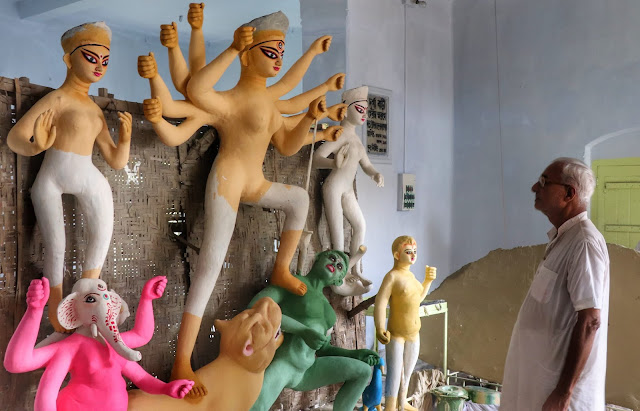 |
| The Durga idol at Manasatala Banerjeebari |
এখান থেকে হাঁটা পথে কিছু দুরেই 'নতুন বাড়ি'। নামে নতুন বাড়ি হলেও এবাড়ির বয়স একশ বছরের উপর, গায়ে প্রাচীনত্বের ছাপ। এবাড়িতে দুর্গাদালান নেই। রাস্তার ধারে নতুন তৈরী দুর্গাদালানে পুজোর আয়োজন।
 |
| The Durga idol of Natunbari Banerjee Family |
এখানে দেখা হল নতুন বাড়ির পরিবারের দুই প্রৌঢ় সদস্যের সঙ্গে। আলাপ করাতে খুব খুশি হলেন। এঁদের মধ্যে একজন ময়দানের স্বনামধন্য ফুটবলার ছিলেন।
 |
| Two senior members of Natunbari Banerjee House |
সব শেষে এবার ফেরার পালা। মহালয়ার সকালে আকাশের মুখ ভারী। মেঘ করে আছে, যে কোন সময় বৃষ্টি নামল বলে। যাবার বেলায় সেই বিষণ্ণতা কিছুটা আমাদেরও ছুঁয়ে গেল। বাড়ির সকলে মিলে অনুরোধ করলেন পুজোর কোন একটা দিনে যদি আসতে পারি। আসার ইচ্ছে অবশ্যই রইল। ভারী সুন্দর লাগলো এনাদের আতিথেয়তা। যেটা সবচেয়ে ভালো ব্যাপার আজকের দিনেও পরিবারের সব সদস্যদের মধ্যে এই আত্মিক বন্ধন। কুলদেবতা অনন্তদেব আর মা দুর্গার কৃপাতেই এই বিরাট পরিবার আজও একসুতোয় গাঁথা রয়েছে।
কৃতজ্ঞতা স্বীকার...
অমিতাভ গুপ্ত
বড়বাড়ির ব্যানার্জী পরিবারের সকল সদস্য, বিশেষ করে সৌমেন এবং পুজা ব্যানার্জী।










